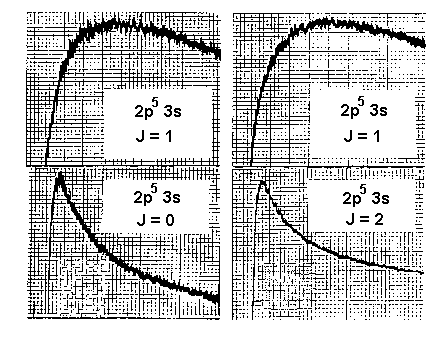II) Electron-Impact Excitation out of the ground state of Atoms
C. Excitation of Neon, Argon
We next consider the heavy rare gases such as neon and argon. The ground state of each of these atoms is the 1S0 state that arises from a np6 configuration. Excited states are formed by moving one of the np6 electrons into a higher orbital, forming a np5n' l configuration.Click here for a neon energy level diagram (GIF file: 950×700).
Click here for an argon energy level diagram (GIF file: 950×700).
Neon 2p5ns levels

As a starting point, let us approach the problem of neon similar to the analysis of helium. First, we describe each configuration by its LS-terms (i.e. singlet, triplets). Next we use optical selection rules to determine the shape of the excitation functions.
|
The 2p5ns configuration has a total of four LS-terms:
|  |
| L = 1 and S = 0, 1 |
If we apply the rules developed for helium, we thus expect to see the three sharply peaked excitation functions for the spin-forbidden triplets, and one broad excitation function for the dipole-allowed 1P term.
However, neon and the heavier rare gases do not generally conform to the LS-coupling scheme. LS-terms with the same total angular momentum J within each configuration are scrambled together. Hence, the two J=1 LS-terms are mixed, while the sole J=0 and sole J=2 LS-terms are left alone. The resulting four levels are labeled using Paschen notation as 1s2, 1s3, 1s4, and 1s5. We now expect that both J=1 levels have some 1P character, and thus both should have a broad peak.
 | J=1 Broad excitation functions |
 | J=1 Broad excitation functions |
 | J=0 Narrow excitation functions |
 | J=0 Narrow excitation functions |
And the experimental data:

Neon 2p5np levels

We now use the same approach for the 2p5np levels. With LS coupling we can have L=0,1,2 and S=0,1. This gives rise to ten LS-terms.
| 1S0, 3P0 | 1P1, 3S1, 3P1, 3D1 | 1D2, 3P2, 3D2 | 3D3 | |||
| Mixing | --Mixing-- | Mixing | J=3 |
And the experimental data:

Argon 3p54p levels

So far, we have only considered the shape of the excitation functions. Let us now examine the magnitudes of the cross sections. For variety, we also switch from neon to argon. The following table lists the cross section at 100 eV for the ten 2p (Pachen notation) of argon in units of 10-20 cm2.
| Levels | J | Q(100 eV) | Levels | J | Q(100 eV) | |||||
|---|---|---|---|---|---|---|---|---|---|---|
| 2p1 | 0 | 59 | 2p2 | 1 | 13 | |||||
| 2p5 | 0 | 25 | 2p4 | 1 | 14 | |||||
| 2p3 | 2 | 28 | 2p7 | 1 | 16 | |||||
| 2p6 | 2 | 23 | 2p10 | 1 | 18 | |||||
| 2p8 | 2 | 39 | 2p9 | 3 | 13 |

This is the same as a one electron excitation 3p (l=1)-->4p (l'=1). From the mulipole field analysis (k=0,1,2,3,...) we find that for l=1-->l'=1, only terms with k=0 and k=2 are compatible and will contribute signifcantly to the cross section. Thus,
| Ar( 3p6, J=0) --> Ar( 3p54p, J'=0 or 2) | allowed | |
| Ar( 3p6, J=0) --> Ar( 3p54p, J'=1 or 3) | forbidden in 1st approximation |

Thus, our standard multipole expansion arguement agrees with the experimental data:
Click here to see this exact case repeated for the neon 2p53p levels.
Neon 2p54d levels

This is the same as a one electron excitation 2p (l=1)-->4d (l'=2). From the mulipole field analysis (k=0,1,2,3,...) we find that for l=1-->l'=2, only terms with k=1 and k=3 are compatible. Thus,
| with | k=1: J=0-->J'=1 | both favorable |
| k=3: J=0-->J'=3 |
Thus, the multipole field analysis would support
This analysis is once again supported by the experimental data for the twelve levels of the 2p54d configuration of neon in units of 10-20 cm2.
| Levels | J | Q(100 eV) | Levels | J | Q(100 eV) | |||||
|---|---|---|---|---|---|---|---|---|---|---|
| 4s1' | 1 | 21 | 4s1" | 2 | 1.6 | |||||
| 4d2 | 1 | 61 | 4s1"" | 2 | 1.3 | |||||
| 4d5 | 1 | 13 | 4d1" | 2 | 1.6 | |||||
| 4s1"' | 3 | 3.1 | 4d3 | 2 | 1.2 | |||||
| 4d1" | 3 | 2.1 | 4d6 | 0 | 0.3 | 4d4 | 3 | 3.4 | 4d4' | 4 | 1.9 |
references:
Experimental and Theoretical Studies of Electron-Impact Excitation of Neon Francis A. Sharpton, Robert M St. John, Chun C. Lin, and Fredric E. Fajen, Physical Review A 2 (1970) 1305-1322.
Electron-Impact Excitation of the Argon Atom James K. Ballou, Chun C. Lin, and Fredric E. Fajen, Physical Review A 8 (1973) 1797-1807.
 |
 |
 |